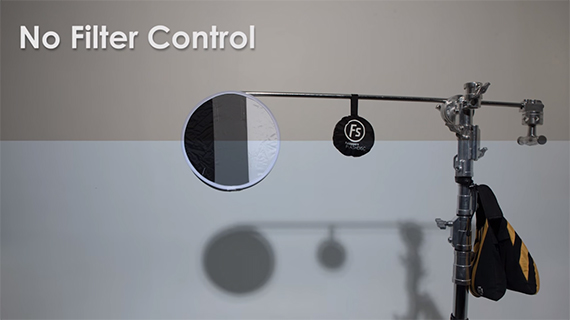Neutral density filters are probably the most powerful photography filters available. These filters sit in front of the lens cutting the amount of light that reaches the camera sensor. In doing so, they allow you to use wider apertures in broad daylight or keep the shutter open for a really long time, producing really smooth effect on water and clouds, for example. There are many different brands and types of filters out there. In this video Patrick Hall from Fstoppers does an in-studio test of five leading brands. Here are the results:
White Balance Test
For this test, Hall set the white balance on his camera to 5000 degrees Kelvin. He then screwed on each ND filter and took a test shot in RAW to check for any color shifts. Interestingly, both the Hoya and the Formatt had a cyan color shift. The Tiffen had a cooler color shift. The B+W had a slightly warmer color tone. The Breakthrough filter was the closest to the control shot.

Hall says the white balance on the Breakthrough filter looks the closest.
Processed and Corrected Test
The next test was to correct the white balance in post-production using the dropper tool. Hall had used a grey card in the test shots to assist with this. However, after correction the images still appeared slightly off. The Hoya looked slightly warmer than the control shot with no filter on, and so were the Tiffen and the Breakthrough. The Formatt Hitech had the closest white balance to the control shot post correction. The B+W was very close to the Formatt.

The processed white balance test: Formatt Hitech (left) vs. B+W (right)
An interesting thing to note was that almost all of the filters were slightly denser than what was advertised. The Hoya, for example, was a fifth of a stop denser, and the Tiffen was three quarters more dense than advertised—it was almost a 7-stop filter. The Formatt was closest to what was advertised, being only a tenth of a stop denser. The B+W was a third of a stop denser, and the Breakthrough was as advertised.
The Vignette Test
The Formatt Hitech showed to have the most vignetting among the five filters tested. The B+W was second on that list. The Breakthrough and the Hoya definitely fared better, with the former having the least amount of vignetting.

The Breakthrough filter had the least amount of vignetting
Sharpness Test
The final test was the sharpness test, and this is where the Tiffen and the Breakthrough scored well. They topped the charts.
Which ND Filter is Best?
So, what’s the takeaway of this exercise? Really, there was nothing that couldn’t be corrected in post-processing. Hall explains,
“To me the only thing it came down to is the price difference in these and the vignetting.”
The B+W was the most expensive and it had a lot of vignetting. The Formatt Hitech, despite being the cheapest, has a fault; it’s not stackable, meaning you can’t add a circular polarizer if you wanted to.

And the winner is: Breakthrough
The winner, according to Hall, was the Breakthrough filter. In spite of being the cheapest, it had a number of points working in its favor. It has a thin profile, it has nice grooves on the sides that allow the filter to be rotated, and the performance is good, too.
Like This Article?
Don't Miss The Next One!
Join over 100,000 photographers of all experience levels who receive our free photography tips and articles to stay current:






Leave a Reply